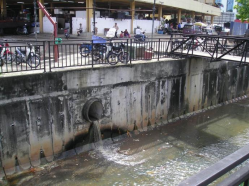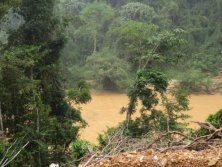Introduction to Pollutant Loads
Water pollution is divided into two, namely Point Sources and Non-Point Sources. Pollution from a point source occurs as a result of effluent discharged to a watercourse or river through an overflow or pipe. Pollution from Non Point Sources is due to rainwater runoff (surface run off) that carries pollutants to the river or to the sea.
POLLUTION LOAD FORMULA
Load = concentration x flow rate
Load (kg/day) = concentration (mg/L) x flow rate (m3/s) x 86.4
Example
The concentration of NH3-N released from Plant Sewage (STP) is 15mg/L with a flow rate of 0.1m3/s
The load of NH3-N released by STP into the river is:
15 mg/L x 0.1 m3/s x 86.4 = 129.6 kg/day
Calculate the NH3-N pollution load in Sg. A that receives the load from the STP. The existing NH3-N concentration in the river is 0.2mg/L (Class II, National Water Quality Standards for Malaysia (NWQS)) with a flow rate of 2 m3/s.
The existing NH3-N load in Sg. A is:
0.2 mg/L x 2 m3/s x 86.4 = 34.6 kg/day
Thus the concentration of NH3-N in Sg. A if the effluent is discharged from the STP is:
(129.6 + 34.6) kg/day ÷ [(0.1 + 2.0) m3/s x 86.4]
= 0.9mg/L (Class III, NWQS)
To ensure an NH3-N concentration of 0.3 mg/L (Class II, NWQS) in river A, what is the allowable concentration of NH3-N released by the STP?
0.3 mg/L x 2 m3/s x 86.4 = 51.84 kg/day
(51.84- 34.6) kg/day = 17.24 kg/day
If a 20% margin of safety is used:
20% x 17.24 kg/day = 13.8 kg/day
13.8 kg/day ÷ (0.1 m3/s x 86.4) = 1.6mg/L











